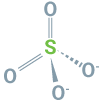



Sulphur
(S)
1. The recycling of nutrients contained in organic matter such as livestock effluent, crop residues and other organic by- products of human activities, is an important resource for fertilization.
2. Fertilizer manufacturing can lead to formulations containing sulphur in sulphate form.
3. Some plant protection products add sulphate or elemental sulphur, which oxidises into sulphate in the soil.
4. Sulphur emissions from factories and vehicle exhaust declined significantly, leading to a sharp drop in atmospheric fallout in the past 40 years.
5. The incorporation into microbial or plant biomass transforms mineral sulphate into organic sulphur. The activity of soil bacteria is mainly stimulated by the presence of ammonia, nitrogen and sulphate. Organic sulphur must be mineralised to be absorbed by plants. Mineralization of organic matter in the soil liberates sulphate.
6. In aerobic conditions, the ultimate form of mineral sulphur is sulphate, but in anaerobic conditions, sulphate may be reduced to sulphide and hydrogen sulphide (H2S).
7. Sulphate leaching occurs mainly in winter, when surplus water carries sulphate out of the reach of roots.
8. Plants only take up sulphur through the roots in sulphate form.
9. Leaf absorption in the form of elemental sulphur (S) vapour is possible, but limited.
10. Sulphur is exported via the harvest as food and fodder.
Very
Fairly
Moderately
| S | SO₃ | ||
|---|---|---|---|
| Cabbage | |||
| Winter Rapeseed | |||
| Spring Barley | |||
| Winter Barley | |||
| Winter Wheat | |||
| Potatoes | |||
| Sugar Beet | |||
| Sunflower | |||
| Apple | |||
| Carrot | |||
| Cherries | |||
| Cucumber | |||
| Grape Vine | |||
| Lettuce | |||
| Pear | |||
| Grain Maize | |||
| Silage Maize | |||
| Strawberry | |||
| Tomato | |||
| Fiber Flax |
Sulphur is not very mobile in the plant. Deficiency generally appears in young leaves, leading to a yellowing of the leaf. It can be easily mistaken for nitrogen deficiency.
Excess sulphur can acidify the soil, which is positive in calcareous soils. Gypsum (calcium sulphate) does not interfere with the pH.
LAT Nitrogen Austria GmbH
St.-Peter-Strasse 25
4021 Linz, Austria
















